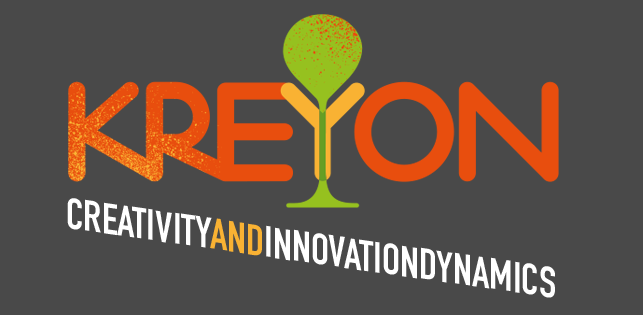
The Kreyon Project is finally online at www.kreyon.net.
NOVELTIES AND THE ADJACENT POSSIBLE
Novelty is part of our everyday experience more than we usually think. We continuously meet new people, adopt new words, listen to new songs, watch a new movie or a video, use a new technology. In addition we constantly leverage our creativity as a natural mode of human nature of finding new valuable solutions to old and emerging problems. At a collective level, innovation is a fundamental factor in the evolution of biological systems, human society and technology.
Often, innovative events do not happen by chance, rather they seem to be triggered by some previous novelty or innovation. In studies of biological, technological, and cultural evolution, it has been hypothesized that one innovation can lay the groundwork for another by creating fresh opportunities. In our daily lives, a similar process may account for why one new thing so often leads to another. This idea has been beautifully summarized by the notion of adjacent possibleintroduced by Stuart Kauffman and popularized by Steven Johnson.
In Johnson’s words,``The adjacent possible consists of all those things (depending on the context, these could be ideas, molecules, genomes, technological products, etc.) that are one step away from what actually exists, and hence can arise from incremental modifications and recombinations of existing material.’”
And ``the strange and beautiful truth about the adjacent possible is that its boundaries grow as you explore those boundaries.”
In this sense, the advance into the adjacent possible is the driving force for correlating innovative events, and novelties are produced through an exploration of a space – physical, conceptual, technological, or biological – that enlarges itself whenever one reaches a point of the space never visited before.
THE CONTEXT
The project is proposing for the first time a unitary approach where creativity and innovation are seen as two sides of the same coin and jointly investigated and modeled. In doing this it exploits the extraordinary alignment of three circumstances:
- The ability to monitor, quantify and model human behaviors at unprecedented levels of resolution and scale, unleashed by the planetary-scale adoption of the World Wide Web, mobile communication technologies, e-commerce systems, and on-line social networks. The possibility to access to digital fingerprints of individuals is opening tremendous avenues for an unprecedented monitoring at a “microscopic level” of collective phenomena involving human beings. We are moving very fast towards a sort of tomography of our societies, with a key contribution of people acting as data gathering “sensors”.
- The opportunities web-gaming and social computation are offering to the emergence of new forms of participation arising from the interplay of ICT services and communities of citizens. In the last few years the Web has been progressively acquiring the status of an infrastructure for social computing that allows researchers to coordinate the cognitive abilities of users in online communities, and to suggest how to steer the collective action towards predefined goals. This general trend is also triggeringthe adoption of web-games as a very interesting laboratory to run experiments in the social-sciences and whenever the peculiar human computation abilities are crucially required for research purposes.
- The maturity of complex systems and data science applied to socio-technical systems. The theoretical and modeling tools recently developed by physicists, mathematicians, computer and social scientists to analyse, interpret and visualize complex data sets have reached the maturity to effectively address the challenges of our era.
The concurrence of all these elements is opening tremendous opportunities towards an understanding of the complexity of our societies, with the final goal of deploying human imagination for the betterment of our communities and even civilization. This project aims at timely leveraging these possibilities to investigate creativity and innovation processes in a quantitative way by blending in a unique ambitious project data-science, web-based experiments and theoretical modeling. Building on these three pillars, the project promises to construct a quantitative framework through which important questions could be raised, refined, polished and eventually answered. We expect, in this way, to trigger a revamped interest of the scientific community and the society at large towards a systematic and quantitative approach to creativity and innovation.
OBJECTIVES
KREYON aims at raising and addressing (without being limited to) the following scientific questions:
- Signatures of the adjacent possible at the individual and collective level. What is its structure and how does it get dynamically reshaped by individual innovative events?
- Operational definition of creativity. To which extent creativity is an individual or a social process? How to quantify the value of a new idea? Great ideas could be useless. But some of them could have a value, though not immediately evident. And also, does creativity require (or is enhanced by) specific constraints?
- Microscopic mechanisms at play. Can we quantify the role of tinkering, recombination, serendipity, trial/error?
- Understanding the deep links among individual creativity, the emergence of novelties and the collective phenomena in innovation dynamics. Novelties should not necessarily be new to the whole history. Some could be new to someone, his own context, workplace and only some of them new to the whole history. How can one tell them apart?
- A matter of scales. Do creativity and innovation proceed gradually or through large leaps? Individual vs. collective effects for innovation. Some new idea could be adjacent for someone and very far for the community (”That’s one small step for [a] man, one giant leap for mankind” effect).
- Paths leading from the early adoption to a large-scale spreading of innovations. How several innovations compete, fail and get successful? Why sometimes innovations can fail because too far ahead of their times?
- Correlation among creative and innovative events. Can one find signatures and of the complex triggering processes among innovations, as predicted by the notion of adjacent possible?
- Adjacent possible in action. Is it possible to identify the best environments and the best strategies to foster creativity and innovation?Interested? Find more at www.kreyon.net.














